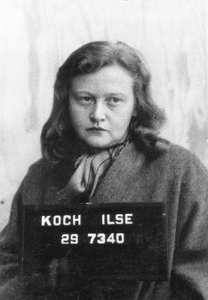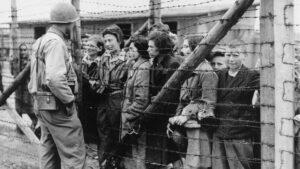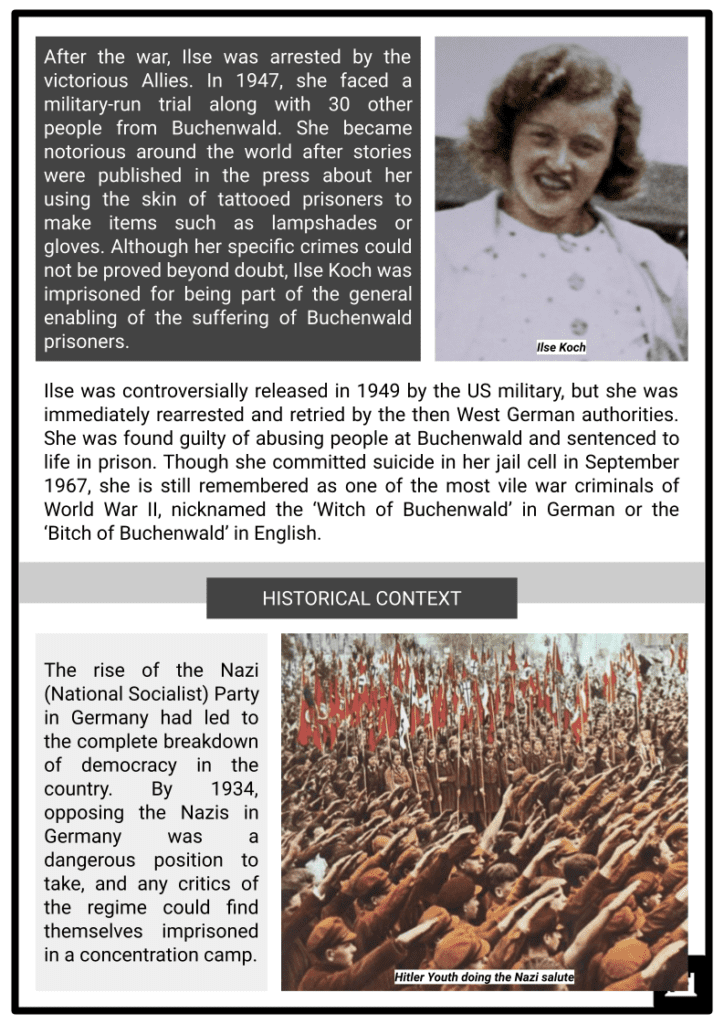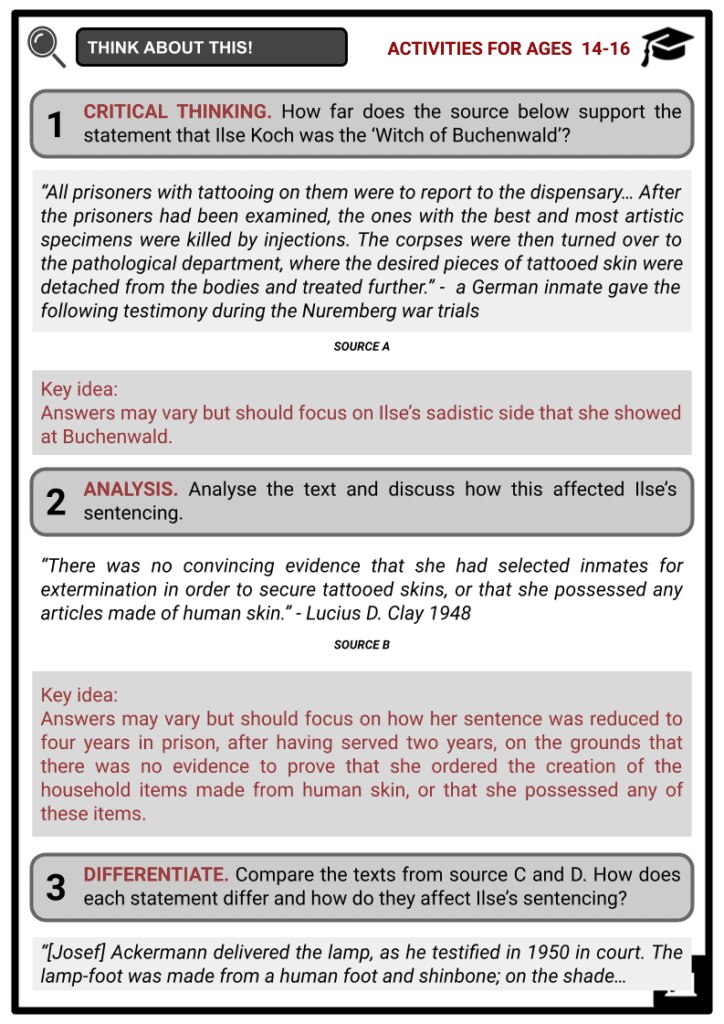Download Ilse Koch Worksheets
Do you want to save dozens of hours in time? Get your evenings and weekends back? Be able to teach about the Ilse Koch to your students?
Our worksheet bundle includes a fact file and printable worksheets and student activities. Perfect for both the classroom and homeschooling!
Table of Contents
Add a header to begin generating the table of contents
Summary
- English and French Royal Houses during the Hundred Years’ War
- Timeline of Significant Events
- The Edwardian War
- The Carolingian War
- The Lancastrian War
- Impact of the Hundred Years’ War
Key Facts And Information
Let’s know more about Ilse Koch!

- Ilse Koch, née Köhler, was born on 22 September 1906 in Dresden, Germany. In 1932, Ilse joined the Nazi Party and became a party secretary. In the course of her work for the Nazis she met Karl-Otto Koch, an SS officer with a criminal background, and the two began a relationship. After working together at Sachsenhausen concentration camp near Berlin, Ilse and Karl Koch married on 25 May 1937.
- Ilse moved to the new Buchenwald concentration camp when her husband became the commandant there in summer 1937. The Kochs lived in luxury at Buchenwald while the inmates starved and suffered. Ilse reportedly took great pleasure in torturing prisoners.
- After the war, Ilse was arrested by the victorious Allies. In 1947, she faced a military-run trial along with 30 other people from Buchenwald. She became notorious around the world after stories were published in the press about her using the skin of tattooed prisoners to make items such as lampshades or gloves. Although her specific crimes could not be proved beyond doubt, Ilse Koch was imprisoned for being part of the general enabling of the suffering of Buchenwald prisoners.
- Ilse was controversially released in 1949 by the US military, but she was immediately rearrested and retried by the then West German authorities. She was found guilty of abusing people at Buchenwald and sentenced to life in prison. Though she committed suicide in her jail cell in September 1967, she is still remembered as one of the most vile war criminals of World War II, nicknamed the ‘Witch of Buchenwald’ in German or the ‘Bitch of Buchenwald’ in English.
HISTORICAL CONTEXT
- The rise of the Nazi (National Socialist) Party in Germany had led to the complete breakdown of democracy in the country. By 1934, opposing the Nazis in Germany was a dangerous position to take, and any critics of the regime could find themselves imprisoned in a concentration camp.
- The first Nazi camp opened at Dachau in 1933, the intention being to use it to gather political prisoners such as communists so as not to overburden the existing prison system. The escalation of the Nazis enforcing their ideology on the population led to more groups being rounded up and incarcerated, such as Roma gypsies and homosexuals. By the time World War II broke out in 1939, the camps were also being used to house and often kill Jews, whose total annihilation was one of the Nazis’ main aims.
- From early on in their existence, the concentration camps were administered by the SS (Schutzstaffel, meaning ‘security squad’). The SS was an elite paramilitary group under the leadership of Heinrich Himmler.
- They had sworn to protect the Nazi Party and rid Germany of all people deemed ‘undesirable’, and were effectively put in charge of law enforcement in the Third Reich. Himmler expected the SS to live up to certain standards of behaviour – an individual officer stealing or taking justice into his own hands was not permitted – while allowing them to carry out all manner of terrible acts.
BIOGRAPHY OF ILSE KOCH
- Ilse Koch was born Margarete Ilse Köhler in Dresden, Germany, on 22 September 1906. Her father was a former soldier turned factory foreman and her mother a housewife. Little is known about her childhood, but perhaps surprisingly, given her later crimes, it is reported to have been a happy and normal one. After leaving school at 15, Ilse trained in accountancy and bookkeeping before getting a job working in the office of a factory.
- During the 1920s, Germany was in turmoil as a result of World War I. The country’s economy was in dire straits and this created an opportunity for more extreme political factions to win support. The National Socialist (Nazi) Party was founded in 1920. It was against the Treaty of Versailles that had imposed punitive reparations on Germany after its defeat in 1918, and was violently opposed to communists and Jews, the latter of which it saw as running global capitalism and profiting from the war.

- At first an insignificant political organisation among many others, the Nazis became more popular as the economic depression persisted through the decade. Its supporters saw it as a way of rebuilding Germany’s strength, and therefore bringing better employment opportunities for themselves and their families.
- By the early 1930s, the Nazis had won seats in the German parliament, the Reichstag, and the political establishment were taking notice. Experienced politicians thought that they could manipulate the Nazis and their leader, Adolf Hitler, to win popular support and increase their own power. Their misjudgement allowed the Nazis to become the leading party in the Reichstag, from which position they began to take control of the state and eliminate their opponents. The first concentration camp, Dachau, was opened in 1933 to house political prisoners.
- Ilse Koch had joined the Nazi Party in 1932 and began working as a secretary within the party. In 1934 she met Karl-Otto Koch, a convicted fraudster who had gone through a number of jobs before joining the SS, the elite paramilitary wing of the Nazi Party. The young woman recognised that the upwardly mobile Koch, ten years her senior, could give her power and privilege, which she had never experienced in her life up to that point. The two then began a relationship.
- Koch served at several of the early concentration camps before being assigned to the newly established Sachsenhausen camp as commandant in 1936. This camp was sited close to Berlin and became the training ground for SS officers who would then go on to other camps further afield. It was also the testing location for the most ‘efficient’ forms of executing prisoners.
- Ilse went with Karl to Sachsenhausen and became an Aufseherin (a female SS guard). These female guards were recruited to supervise female prisoners, of which there were up to 2,000 at Sachsenhausen. Karl Koch pleased his SS superiors with the way he ran Sachsenhausen, and he was soon selected for a prestigious transfer – to help build and then run a new concentration camp called Buchenwald, near the city of Weimar.
- Heinrich Himmler expected his SS officers to live up to the highest standards of his morality, which included marrying a suitable woman and having children who could be raised as ideal citizens of the Reich. Ilse Köhler’s ancestry was checked to make sure that her lineage was suitably ‘pure’ as an SS bride. Passing the test, Ilse wed Karl in a torchlit SS ceremony before beginning married life at Buchenwald.
- The Kochs milked their new positions for all they were worth. A luxurious villa was built next to the camp for them, and there was even a zoo for the entertainment of all the SS officers and their families. Despite the barbaric way in which he allowed his prisoners to be treated, Karl Koch enforced strict discipline on SS officers who mistreated the animals in the zoo.
- When Jewish prisoners started to come to Buchenwald in large numbers in 1938, a whole new stream of income opened up for the corrupt commandant and his wife. They took the prisoners’ money and valuables for themselves, accumulating a great deal of wealth. Ilse Koch spent 200,000 Reichsmarks, about £850,000 in today’s money, on building an indoor arena for the sole purpose of riding her horses.
- As the wife of the commandant, Ilse was expected to be a good housewife and mother, and have a cosy home waiting for her husband every evening when he returned from his duties. But this was not enough for Ilse.

- At Buchenwald, she was able to indulge her most amoral tendencies almost without consequences. As well as using the prisoners’ belongings to enrich herself, she also demonstrated a deeply sadistic side. Witnesses later reported that she would wear revealing clothes around the prisoners, and if one of them even glanced at her, she would note his number and report him to her husband for a severe beating. She also conducted affairs with at least two married SS officers in the camp. But this was not what Ilse Koch became notorious for.
- At Buchenwald, Dr Erich Wagner was writing a scientific study about tattoos, and how much they could be associated with criminal behaviour. Buchenwald, particularly in its early years, contained many criminals, and so was suitable for a study of this kind. Ilse Koch was said to keep her eyes out for any particularly interesting tattoos on prisoners so that she could tell Dr Wagner about them. The prisoners in question would then be taken for examination and study, and reportedly were never seen again. Rumours flew round the camp that Ilse Koch ordered the doctor to use the tattooed skin to make household curios for her: book covers, lampshades, even gloves and a handbag.
- This was not the end of the investigation into the Kochs’ activities. The head of the SS in the Buchenwald area, Josias, Hereditary Prince of Waldeck and Pyrmont, had a personal dislike of Karl Koch, who came from a much lower-class background than him. He had noticed a name he knew on the death lists of Buchenwald (the SS scrupulously kept records of every death) – a medical man who had once treated him.
- Karl Koch’s reign at Buchenwald came to an end in 1941, when at least some of his nefarious deeds caught up with him. An investigation by the SS revealed the scale of his theft from the prisoners of Buchenwald – the problem was not that he had done it, but that he had kept too much for himself instead of declaring it to his superiors. As punishment, Koch was transferred to work at the death camp at Majdanek, but Ilse remained behind at Buchenwald. The marriage by this point had broken down, although there would be no question of divorce as it went against the ethos of the SS.
- Ordering the case to be looked into, the prince came to believe that Karl Koch had engineered the deaths of this man, Walter Krämer, and two others at Buchenwald to conceal the fact that he had been diagnosed with the sexually transmitted disease syphilis.
- In August 1943, both Karl and Ilse Koch were arrested, he for incitement to murder and embezzlement, and she for theft. The prosecutor, Georg Morgen, presented evidence showing that the Kochs’ life of luxury far surpassed what should have been manageable on their salaries.
- In December 1944, Karl Koch was found guilty and sentenced to death, but his wife Ilse was acquitted. Morgen was convinced of her guilt, but there was not enough evidence directly linking her to the alleged crimes. Karl Koch was shot by an SS firing squad on 5 April 1945, ironically back at Buchenwald. The camp was liberated by advancing US troops just days later. Ilse, meanwhile, had gone to live in Ludwigsburg with her two children. But she would find herself incarcerated again just after the end of the war in Europe, in June 1945, after she was recognised by a former Buchenwald prisoner.
- This time she was in the custody of the American military. Along with 30 other people formerly associated with the Buchenwald camp, she faced trial over several months in 1947. The world’s media followed the trial of Ilse Koch with almost salacious interest. The legend of the ‘Lady of the Lampshade’ had horrified and fascinated people when it emerged in the final days of the war.
- Ilse, the only woman among the defendants at the trial, became a symbol of the cruelty of Buchenwald and even the entire concentration camp system. However, no evidence was presented at her trial that directly proved the grisly stories.
- Ilse Koch was found guilty under the ‘common design’ principle, in which all defendants were considered to have committed crimes just by being part of the Buchenwald administration. She escaped the death penalty because she was by then seven months’ pregnant, having conceived a child with a fellow prisoner while awaiting trial.
- Following the trial, the American authorities revisited the convictions and reduced many of the sentences they had handed down, including Ilse’s. This was because many of the victims at Buchenwald had been German, and the American military no longer felt that they should have jurisdiction over the crimes.
- Ilse Koch was released in 1951 to an outcry from the general public in the US. However, she was immediately rearrested by the West German authorities, and put on trial for a third time.
- As she had all along, Ilse denied any knowledge of the crimes of which she was accused. She professed only to have been a housewife at Buchenwald. During the trial at Augsburg, she twice collapsed in court and had to be removed. She was sentenced in her absence to life in prison. Over the following years, she repeatedly tried to appeal her conviction, but was unsuccessful. Though Ilse’s child, Uwe, which she conceived while in prison, was taken at his birth in 1947 to be put into foster care, she was able to reunite with him before committing suicide in Aichach prison on 1 September 1967.






